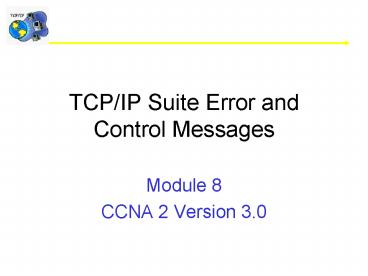TCPIP Suite Error and Control Messages - PowerPoint PPT Presentation
1 / 13
Title:
TCPIP Suite Error and Control Messages
Description:
ICMP is part of the TCP/IP protocol suite. Two functions performed by ... sending and receiving devices must have the TCP/IP protocol stack properly configured ... – PowerPoint PPT presentation
Number of Views:40
Avg rating:3.0/5.0
Title: TCPIP Suite Error and Control Messages
1
TCP/IP Suite Error and Control Messages
- Module 8
- CCNA 2 Version 3.0
2
IP and ICMP
- IP is known as a best effort delivery mechanism
- Considered unreliable
- has no built-in processes to ensure that data is
delivered - ICMP is an error reporting protocol for IP
- Used to send and receive error and control
messages to hosts on a network
3
ICMP Messaging
- ICMP is part of the TCP/IP protocol suite
- Two functions performed by ICMP
- Error messaging
- Control messaging
4
ICMP Message Delivery
- ICMP messages are encapsulated into datagrams in
the same way any other data is delivered using IP - Errors created by ICMP messages do not generate
their own ICMP messages - It is possible to have a datagram delivery error
that is never reported back to the sender of the
data
5
ICMP Message Types
- All IP implementations must include ICMP support
- ICMP messages have special formats with their own
unique characteristics - Control messages are used to inform hosts of
conditions such as - network congestion
- the existence of a better gateway to a remote
network
6
Error Reporting
- ICMP reports on the status of the delivered
packet only to the source device. It does not
propagate information about network changes to
routers.
Router C notifies ONLY Workstation 1 that the
datagram could not be delivered
Suppose, Workstation 1 sends a packet to
Workstation 6
Interface Fa0/0 goes down on Router C
7
TTL (Time to Live)
- If a circular routing path exists or there are
too many hops to a destination, a packet will
eventually exceed the maximum hop count - This is also known as reaching its time-to-live
(TTL) - the TTL value typically matches the maximum hop
count defined by the routing protocol - A TTL value is defined in each datagram
- As each router processes the datagram, it
decreases the TTL value by one - When the TTL of the datagram value reaches zero,
the packet is discarded - ICMP uses a time exceeded message to notify the
source device that the TTL of the datagram has
been exceeded.
8
Review of Network Communications
- Network communication depends upon certain basic
conditions being met - sending and receiving devices must have the
TCP/IP protocol stack properly configured - includes the installation of the TCP/IP protocol,
proper configuration of IP address and subnet
mask, and configuration of a default gateway if
datagrams are to travel outside of the local
network - intermediary devices must be in place to route
the datagram from the source device and its
network to the destination network - Routers serve this function (routers also must
have the TCP/IP protocol properly configured on
their interfaces and use an appropriate routing
protocol)
9
PING (Packet Internet Groper)
- ICMP can be used to test the availability of a
particular destination (tests network
connectivity) - ICMP issues an echo request message to the
destination device - The echo request message is typically initiated
using the ping command
10
PING Contd
- In the following example, PING issues four echo
requests and receives four echo replies,
confirming IP connectivity between the two
devices.
11
Destination Unreachable
- ICMP destination unreachable message header
- The value of 3 in the type field indicates it is
a destination unreachable message.
- The code value indicates the reason the packet
could not be delivered. - Below shows the meaning for each possible code
value in a destination unreachable message
12
Congestion and Flow Control Messages
- Congestion can occur when
- multiple computers try to access the same
destination at the same time - traffic from a high speed LAN reaches a slower
WAN connection - Dropped packets occur when there is too much
congestion on a network - ICMP source-quench messages are used to reduce
the amount of data lost - The source-quench message asks senders to reduce
the rate at which they are transmitting packets
- A small office home office (SOHO) where several
computers are sharing a slow Internet connection
is a scenario where ICMP source-quench messages
might be used effectively
13
TCP/IP Suite Error and Control Messages
THE END
- Module 8
- CCNA 2 Version 3.0































